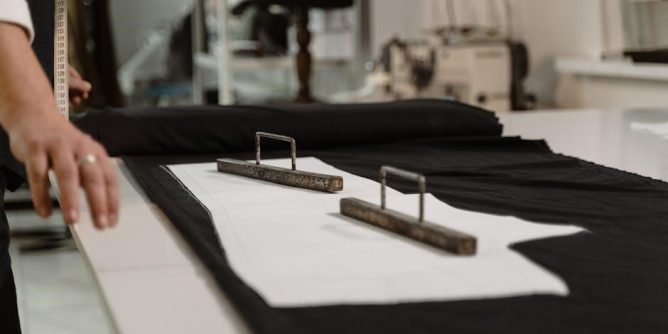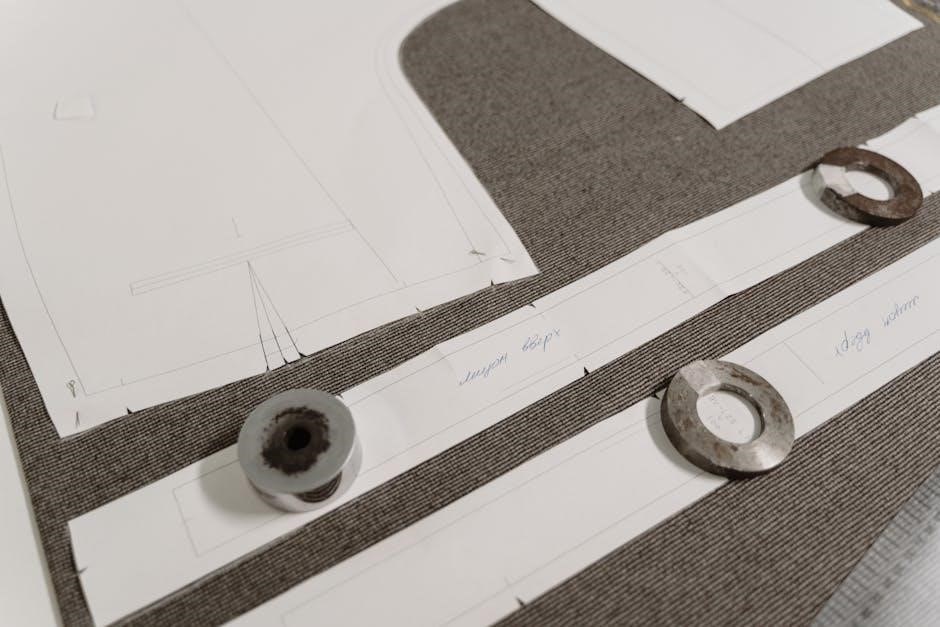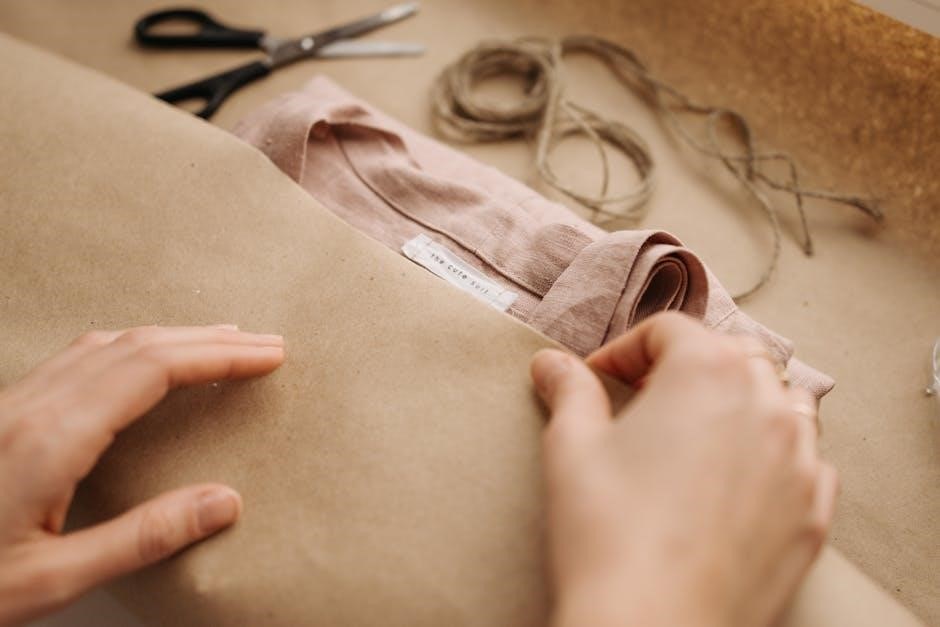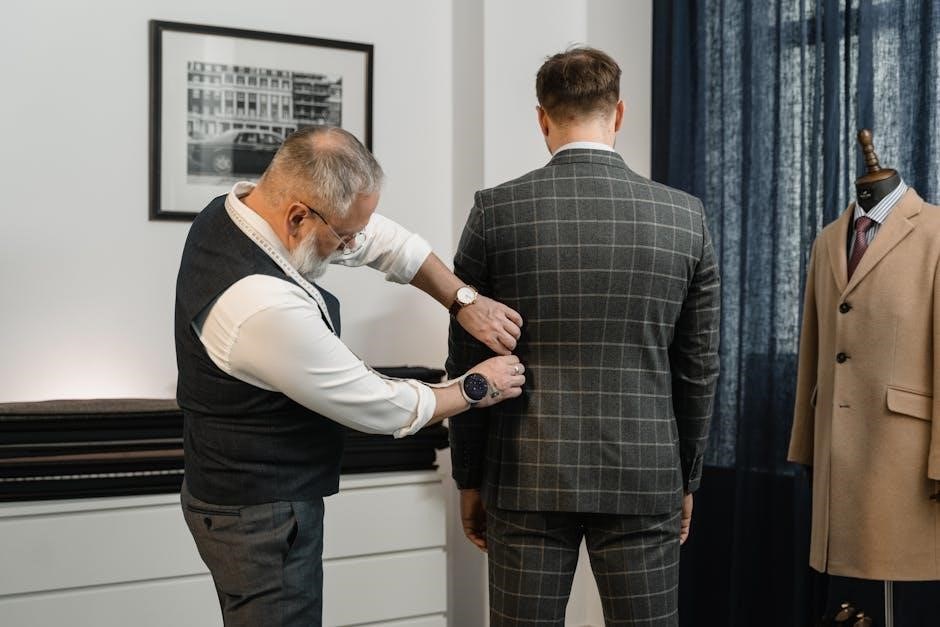
A well-fitted shirt enhances confidence and style‚ ensuring comfort and polish․ Proper measurements are key to achieving the perfect fit‚ whether for dress shirts or casual wear․
1․1 Why Proper Fit Matters
A well-fitted shirt is essential for both style and comfort․ Proper fit ensures the shirt looks polished and professional‚ enhancing your overall appearance․ A shirt that is too tight can restrict movement and feel uncomfortable‚ while one that is too loose may appear sloppy․ Accurate measurements are crucial for achieving a balanced look that complements your body type․ Whether for dress shirts‚ casual wear‚ or custom tailoring‚ the right fit ensures confidence and comfort․ Poor fit can lead to discomfort and an unflattering silhouette‚ making proper measurements vital for selecting or tailoring shirts․ Understanding the importance of fit helps you make informed choices‚ ensuring your wardrobe reflects your personal style effortlessly․
1․2 Understanding Shirt Sizes
Shirt sizes are determined by key measurements‚ including neck‚ chest‚ sleeve length‚ and waist․ These measurements vary between brands and styles‚ making it important to refer to specific size charts․ Slim-fit shirts are tailored closer to the body‚ while regular-fit shirts offer more room for comfort․ Understanding these differences helps in selecting the right size for your body type and preferred fit․ Accurate measurements ensure a polished look‚ whether for dress shirts or casual wear․ By comparing your measurements to size charts‚ you can determine the best fit for your needs․ Proper sizing enhances both comfort and style‚ making it essential to take precise measurements or use a well-fitting shirt as a guide․

Essential Shirt Measurements
Key measurements for a well-fitted shirt include neck‚ chest‚ sleeve length‚ waist‚ and shoulder width․ Accurate measurements ensure comfort‚ style‚ and a polished appearance․
2․1 Measuring the Neck
Measuring the neck is a fundamental step in determining shirt size․ Place the tape measure around the neck‚ just below the larynx‚ with one finger inserted for comfort․ Ensure the tape is level and not too tight or loose; The measurement is used to determine the collar size‚ which is crucial for both comfort and style․ For the most accurate fit‚ the tape should be snug but allow space for one finger․ This measurement is then compared to size charts to find the ideal collar size․ Proper neck measurement ensures the shirt sits comfortably and looks polished‚ avoiding a collar that is too tight or too loose․ Accurate neck measurement is essential for achieving a well-fitted shirt‚ whether for dress or casual wear․
2․2 Measuring the Chest
Measuring the chest ensures a shirt fits comfortably around the torso․ Stand upright and place the tape measure under the armpits‚ wrapping it around the fullest part of the chest․ The tape should be horizontal‚ parallel to the floor‚ and not too tight or loose․ For men‚ this typically aligns with the nipple line‚ while for women‚ it should be around the bust․ The measurement is doubled when laying a shirt flat to measure width․ This ensures the shirt isn’t too restrictive or baggy‚ providing a balanced fit․ Accurate chest measurement is vital for determining the correct size‚ ensuring comfort and a polished appearance in both casual and formal shirts․ Proper alignment and tension are key to achieving precise results․
2․3 Measuring the Waist
Measuring the waist ensures a shirt fits comfortably around the midsection․ Locate the narrowest part of the torso‚ typically just above the hipbone and below the ribcage․ Wrap the tape measure around this area‚ keeping it level and not too tight or loose․ The measurement should be taken with the shirt buttoned if using an existing garment․ For tailored fits‚ this ensures the shirt isn’t too tight or boxy‚ while for casual styles‚ it allows a relaxed silhouette․ Accurate waist measurement is crucial for achieving a balanced fit‚ avoiding discomfort or an unflattering shape․ Proper alignment and a natural stance are essential for precise results‚ ensuring the shirt complements the body without restricting movement or looking ill-fitting․ This step is vital for both men’s and women’s shirts‚ across all styles and fabrics․ Consistency in measurement technique guarantees the best fit․
2․4 Measuring Sleeve Length
Measuring sleeve length ensures a shirt fits perfectly from shoulder to cuff․ Start at the center back of the neck‚ just below the collar‚ and run the tape measure over the shoulder‚ down to the elbow‚ and end at the wrist bone․ For a standard fit‚ the sleeve should reach the base of the thumbnail when arms are relaxed․ If using an existing shirt‚ lay it flat and measure from the shoulder seam to the cuff edge‚ ensuring accuracy․ Proper sleeve length prevents the shirt from being too short or overly long‚ offering a polished appearance․ This measurement is crucial for both casual and dress shirts‚ ensuring comfort and style․ Accurate sleeve length contributes to a well-tailored look‚ enhancing overall fit and confidence․ It’s a key detail in achieving a shirt that flatters any body type or preference․ Consistency in measurement technique is essential for optimal results․
2․5 Measuring Shoulder Width
Shoulder width measurement is essential for ensuring a shirt fits seamlessly across the upper body․ To measure‚ place the tape horizontally across the back‚ starting from the tip of one shoulder and ending at the tip of the other․ Ensure the tape is level and parallel to the floor for accuracy․ This measurement helps determine how the shirt will sit on the shoulders‚ preventing it from being too tight or loose․ For tailored or dress shirts‚ precise shoulder width ensures the garment drapes correctly‚ enhancing both comfort and appearance․ Proper alignment avoids bunching or strain‚ contributing to a polished‚ professional look․ Accurate shoulder measurements are vital for achieving a custom-fit shirt‚ making it a critical step in the measurement process․ This ensures the shirt complements the body structure‚ providing a flattering and comfortable fit․ Consistency in technique guarantees reliable results‚ making it a cornerstone of shirt measurement․

Measuring Techniques
Mastering measuring techniques ensures accurate shirt fit․ Use a flexible tape measure‚ keep it level‚ and avoid pulling too tight or loose for precise results․
3․1 Tools Needed for Accurate Measurements
To ensure precise shirt measurements‚ use a flexible measuring tape made of durable materials like fiberglass or nylon․ A full-length mirror is essential for visibility and accuracy․
3․2 Tips for Taking Measurements Yourself
When measuring yourself‚ stand naturally with feet shoulder-width apart․ Keep the tape measure level and not too tight․ For chest measurements‚ place the tape under your arms and across the widest part of your chest․ For neck measurements‚ position the tape just below the larynx with one finger underneath for comfort․ Sleeve length is measured from the center back of the neck‚ over the shoulder‚ and down to the desired cuff length․ Waist measurements should be taken at the narrowest point‚ ensuring the tape is not too snug or loose․ Use a mirror to ensure accuracy and consistency․ Always take measurements on bare skin for the most precise results․ Double-check your measurements to avoid errors․ If unsure‚ consider having someone assist you for better accuracy․ This will help ensure a well-fitting shirt every time․

Using an Existing Shirt as a Guide
Lay your favorite-fitting shirt flat and measure its key dimensions‚ such as chest‚ sleeve length‚ and waist‚ to compare with size charts for accuracy․
4․1 How to Measure a Favourite Shirt
To measure a favourite shirt‚ lay it flat on a smooth surface․ For chest measurement‚ place the tape across the underarm seams and double the width․ Waist measurement is taken at the narrowest point‚ ensuring the shirt is buttoned․ Sleeve length is measured from the collar base to the cuff edge․ Shirt length is measured from the collar base to the hem․ Compare these measurements to size charts for accurate fit․ This method ensures consistency and helps determine the ideal size when shopping or tailoring․ Always use a flexible tape measure for precision and keep the shirt smooth during measurement․ This approach simplifies finding the perfect fit without the need for self-measurement․
4․2 Comparing Measurements to Size Charts
Once you have measured your favourite shirt‚ compare these measurements to the brand’s size chart to determine your ideal fit․ Start by aligning the chest measurement with the chart‚ as this is a primary indicator of size․ Next‚ compare the sleeve length and waist measurements to ensure they match your preferences for fit․ Note that size charts can vary between brands and styles‚ so it’s essential to refer to the specific chart for the shirt you’re purchasing․ Slim-fit and regular-fit shirts will have different measurements‚ so choose the one that aligns with your body type and desired comfort level․ This step ensures a precise fit and helps avoid sizing discrepancies․ Always double-check measurements for accuracy to guarantee the best possible fit․

Understanding Shirt Size Charts
Shirt size charts vary by brand and style‚ detailing measurements for neck‚ chest‚ and sleeve length․ Slim-fit and regular-fit options cater to different body types and preferences․
5․1 Slim Fit vs․ Regular Fit
Slim-fit shirts are tailored closer to the body‚ offering a modern‚ streamlined look․ They are ideal for those with a lean build or who prefer a fashionable appearance․ Regular-fit shirts‚ on the other hand‚ provide a classic‚ comfortable style with more room around the chest and waist․ They suit a broader range of body types and are perfect for everyday wear․ When choosing between the two‚ consider your body type and personal style preferences․ Slim-fit shirts are great for layering under jackets‚ while regular-fit shirts offer versatility and ease of movement․ Both options ensure a polished look when measurements are accurate․
5․2 How to Read and Use Size Charts
Understanding and using size charts effectively is crucial for achieving the perfect shirt fit․ Start by identifying your key measurements‚ such as neck‚ chest‚ and sleeve length․ Compare these to the chart‚ ensuring alignment with your desired fit—slim‚ regular‚ or relaxed․ Pay attention to the differences between body measurements and garment measurements‚ as charts often reflect the latter․ Consider the fabric type and how it may affect sizing․ For accuracy‚ double-check measurements against a well-fitting shirt or seek professional tailoring advice․ Always review brand-specific charts‚ as sizes can vary․ By matching your measurements to the chart and understanding fit preferences‚ you can confidently select the right size for a polished‚ comfortable look․

Specialized Shirt Measurements
Specialized shirt measurements cater to different styles‚ ensuring a precise fit for dress shirts‚ casual wear‚ and tailored pieces‚ focusing on neck‚ sleeve‚ and chest accuracy․
6․1 Dress Shirt Measurements
Dress shirt measurements are tailored for a polished‚ professional look; Key measurements include neck circumference‚ sleeve length‚ chest width‚ and waist․ The neck is measured just below the larynx‚ with the tape loose enough to fit one finger․ Sleeve length is measured from the center back of the neck‚ over the shoulder‚ to the wrist bone․ Chest measurement is taken around the fullest part‚ ensuring the tape is horizontal․ Waist is measured at the narrowest point‚ typically just above the hipbone․ These precise measurements ensure a custom fit‚ whether for slim or regular styles․ Accurate sizing guarantees comfort and a sharp appearance‚ making dress shirts look tailored to perfection․
6․2 Casual and T-Shirt Measurements
Casual and T-shirt measurements focus on comfort and a relaxed fit․ Key measurements include chest‚ waist‚ length‚ and sleeve length․ The chest is measured around the fullest part‚ ensuring the tape is horizontal․ Waist is measured at the narrowest point‚ typically just above the hipbone․ Shirt length is measured from the base of the collar to the hem․ Sleeve length for short sleeves is measured from the shoulder seam to the hem‚ while long sleeves are measured from the center back of the neck‚ over the shoulder‚ to the wrist․ These measurements ensure a comfortable‚ relaxed fit‚ ideal for everyday wear․ Comparing these measurements to size charts helps determine the perfect size for casual shirts‚ ensuring ease of movement and a flattering silhouette․

Body Type Considerations
Understanding your body type—slim‚ athletic‚ or larger—helps tailor measurements for a customized fit‚ ensuring shirts complement your physique and meet personal style preferences effectively․
7․1 Measurements for Different Body Types
Accurate shirt measurements vary based on body type․ For slim builds‚ ensure a tailored fit by measuring closely around the neck‚ chest‚ and waist․ Athletic individuals may require slightly more room in the chest and shoulders․ Larger body types benefit from relaxed measurements‚ ensuring comfort without restrictiveness․ Use a flexible tape measure to capture the fullest part of the chest and the narrowest waist point․ For sleeves‚ measure from the shoulder to wrist‚ adjusting for muscular arms if necessary․ Consider layering preferences to avoid tightness․ Proper alignment with body contours ensures a polished look․ Tailor measurements to personal comfort and style‚ whether slim-fit or loose-fit․ This approach guarantees a shirt that flatters and fits perfectly‚ regardless of body type or lifestyle․
7․2 Adjusting Measurements for Fit Preferences
Adjusting measurements ensures your shirt fits precisely to your style․ For a slim fit‚ reduce chest and waist measurements slightly while maintaining sleeve length․ A relaxed fit requires adding 1-2 inches to chest and waist for comfort․ Tailored styles balance proportions‚ while loose fits offer more room․ Consider layering needs; add 1-2 inches to chest if layering over sweaters․ Sleeves can be adjusted for cuff placement‚ measuring from shoulder to preferred wrist length․ Ensure the tape measure is snug but not tight for accurate results․ Personalizing fit preferences enhances comfort and aesthetics‚ making each shirt uniquely suited to your lifestyle and wardrobe needs․ This customization ensures every shirt looks polished and feels tailored to perfection‚ regardless of your fit choice․

Importance of Precise Measurements
Precise measurements ensure a polished look and proper fit‚ avoiding sloppy or tight clothing․ Accurate sizing guarantees comfort and style‚ making custom tailoring and alterations seamless and effective․
8․1 Ensuring a Polished Look
A polished look begins with accurate measurements‚ ensuring your shirt fits seamlessly․ Proper chest and neck measurements prevent tightness or looseness‚ creating a professional appearance․ Sleeve length and shoulder width must align with your body to avoid an ill-fitting silhouette․ By comparing your measurements to size charts‚ you can select the ideal fit‚ whether slim or regular․ Attention to detail in measurements elevates your style‚ making you look put-together and confident․ This precision is especially crucial for dress shirts‚ where a polished look is essential for formal occasions․ Custom tailoring benefits greatly from exact measurements‚ ensuring alterations are flawless․ Ultimately‚ precise measurements transform a ordinary shirt into a tailored masterpiece‚ enhancing your overall aesthetic․
8․2 Custom Tailoring and Alterations
Custom tailoring and alterations rely heavily on precise measurements to craft shirts that perfectly suit your frame․ By measuring key areas like the neck‚ chest‚ and sleeves‚ tailors can create bespoke fits that flatter your body․ Accurate measurements ensure that every detail‚ from collar size to cuff placement‚ is tailored to your preferences․ Whether adjusting an existing shirt or creating a new one‚ precise data helps avoid costly mistakes․ Tailors use these measurements to adjust patterns and fabrics‚ ensuring a seamless fit․ Regular updates to your measurements can refresh your wardrobe‚ maintaining a polished look․ Custom tailoring transforms your shirt into a unique‚ personalized garment‚ reflecting your style and fit preferences with exceptional craftsmanship․

Common Mistakes to Avoid
Incorrect measuring techniques‚ ignoring body type‚ and not accounting for fit preferences are common errors․ Double-check measurements and consider consulting a professional for accuracy․
9․1 Measuring Incorrectly
One of the most frequent mistakes is measuring incorrectly‚ which can lead to ill-fitting shirts․ Many individuals fail to use a flexible tape measure or neglect to keep it level‚ resulting in skewed measurements․ Additionally‚ measuring too tightly or too loosely is a common error‚ as it can misrepresent actual body dimensions․ For instance‚ measuring the neck without allowing space for comfort or measuring the chest while it’s not fully relaxed can throw off the fit entirely․ To avoid this‚ ensure the tape measure is snug but not constricting‚ and maintain a consistent posture during measurements․ Taking multiple measurements and averaging them can also help improve accuracy․ Consulting a professional or using a guide can further minimize errors and ensure precise results․ Proper technique is essential for achieving a shirt that fits perfectly and comfortably;
9․2 Ignoring Body Type
Ignoring body type is a common mistake that can lead to poor-fitting shirts․ Different body types‚ such as broad shoulders‚ slim waists‚ or athletic builds‚ require tailored measurements․ Failing to account for these differences often results in sleeves that are too tight or too loose and shirts that are either overly baggy or restrictive․ For example‚ individuals with broader shoulders may need a shirt with more room in the chest and sleeves‚ while those with slimmer frames might prefer a slimmer fit․ Using size charts without considering body type can lead to discomfort and an unpolished appearance․ To avoid this‚ measure carefully and choose shirts designed for your specific body type‚ ensuring a balanced fit that flatters your physique․ This approach guarantees a more tailored and comfortable result․ Proper consideration of body type is essential for achieving the perfect shirt fit․

Pro Tips for Perfect Fit
Choose fabrics that complement your body type and lifestyle․ Measure for layering by adding 1-2 inches to chest and sleeve measurements․ Ensure precise alignment for a tailored look․
10․1 Choosing the Right Fabric
Selecting the appropriate fabric is crucial for both comfort and aesthetics․ For dress shirts‚ cotton is a popular choice due to its breathability and softness․ Linen is ideal for warmer climates as it offers excellent ventilation․ Polyester blends are durable and low-maintenance‚ making them suitable for casual wear․ Consider the season and occasion when making your choice․ Lightweight fabrics like voile or chambray are perfect for summer‚ while heavier materials such as flannel provide warmth in winter․ The fabric’s texture and drape will also influence the fit‚ ensuring your shirt looks polished and feels great against the skin․ Always match the fabric type to your lifestyle and preferences for the best results․
10․2 How to Measure for Layering
When measuring for layering‚ consider how shirts will fit together․ For a base layer‚ ensure a snug fit without restriction․ Add 1-2 inches to chest and sleeve measurements for an outer layer to accommodate the underlying shirt․ Measure sleeve length to ensure it extends beyond the base layer’s cuffs․ Chest and waist measurements should allow for effortless movement․ If layering a dress shirt over a T-shirt‚ add 0․5-1 inch to the chest and shoulder measurements․ Consider the fabric thickness of both layers to maintain comfort and avoid bulkiness․ Properly aligned shoulder and sleeve measurements are crucial for a polished look․ Use these adjusted measurements to match size charts for a seamless‚ layered wardrobe․